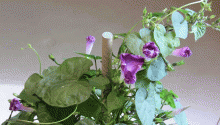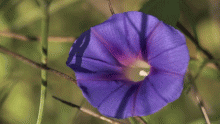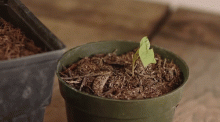When you know what to plant next to this or...
-
Morning glory plants are extremely beautiful annual climbers that have slender stems, trumpet-shaped flowers in white, pink, magenta or purple blue colors and heart-shaped leaves. Any flower has a beautiful shape both before it unfolds in the sun and after it opens in its full.
Morning Glory Plants. Know the Greatest Climbing Vine for Your Backyard
Normally, this rapidly growing vine is related to sweet potato with pink, blue, red and multicolored flowers. In some cases there are even double forms. Thanks to being easy, fast and colorful, the plant is among the most popular annual vines.

The flower like this one blooms from early summer and to the first frost. Big, colorful and fragrant plants attract hummingbirds and butterflies. The vines grow pretty fast and can reach the size of 15 feet in one season only. Besides, they can self-seed easily as well.
Wild weed that is today referred to as field bindweed is a distant relative of the morning glory plant that is colorful and grows in many gardens and backyards. Its seeds can be highly toxic, if they are ingested. Even comparatively mild intoxication may be accompanied with a number of symptoms. The most serious among them are canine health problems.
Plant’s species are mostly native to tropical America. However, the flowers can also be quite easily found in Asia, temperate and subtropical areas. In fact it is a common name that can be referred to various types of morning glory that belong to one family (Ipomoea, Calystegia, Convolvulus, Rivea and Merremia). They all have slight differences, but there is no need to start worrying about proper identification. The plant tag or seed packet always identifies the flower by its species and genus. They have morning glory images and pictures, so you can easily choose the type you like the most.
Let’s find out more about how to plant a morning glory and take care of it. You’ll see that how to prune morning glory is the procedure that can be done by anyone.
Secrets of Planting Morning Glory: More on Propagation from Seeds and Cutting
Planting morning glory is easier than you think. New vines are usually started from seeds. We suggest soaking them in water for twenty-four hours before planting. This speeds up germination greatly. In Northern areas they start indoors in pots 4-6 weeks before planting, which helps to achieve the bloom much earlier. Usually germination takes up to one week, if at 70-80 degrees Fahrenheit. When to transplant? 5-6 weeks after being planted in pots. The process of transplanting to the garden must be done without disturbing the roots.
NB. Be very careful. The thing is vines grow very quickly and can get tangled up, if only you don’t give those pieces or stakes of bamboo to grow up. Of course, if you don’t have enough time for indoor care, you can direct seed outdoors, when the danger of frost has already passed.
Some gardeners prefer taking a morning glory cutting to plant in the soil. This type of propagation is getting pretty popular as well, but such vines take much time to flower, and that’s why it is suggested to start pruning them early.
Care Guide: Top Things You Should Know
Plant cultivation always seems to be a pretty hard task to cope with, but not if you have instructions to follow. Care for morning glory always becomes real pleasure, if you see positive results.
So, what to start with? Watering is of top importance. You should water the area in order to moisten the soil. It is essential to keep it evenly moist, but not overwater, as the seeds will soon rot. As a rule, it takes up to 4-7 days for the seeds to germinate. After the plant is up you can cut back on watering. Never allow the soil to dry out completely.
Secondly, it is important to train the vines to climb the trellis or fence. This can be done by weaving their ends in an in-and-out fashion. Some people use strings and twist ties to get the vines started. These simple care instructions will help you to succeed in the growing the plant.
Thirdly, fertilization should become a regular procedure in the process of caring for morning glory. Feed the plant using a phosphorous-rich and low-nitrogen based fertilizer. In case it has too much nitrogen, there will be few flowers, but many leaves. Do the feeding once every month during the active growing season. You won’t waste your time, if you read label instructions for the proper amounts, as well as times, to give the plant some fertilizer.
How to Care? Top 4 Simple Rules
- Provide support systems to upcoming vines.
- Reduce the reseeding capability by removing all dead vines.
- Keep in mind that thanks to the reseeding capability there’s no need to replant these species.
- The plants like these are favorites of sun, so make sure you don’t overheat them.

Basic Morning Glory Growing Tips: Way to Success
FYI, morning glories grow with little care. Before transplanting them to their permanent location, it is highly important to assure they will receive good drainage and sun there. These aren’t water lovers and usually aren’t tolerable to soggy soil. To succeed in the growing process, water the plants twice every week during hot and dry periods.
Always provide support, as these are twiners that are seeking out something to grab and hold. As they are growing upward, insert twigs for support, watching out for the roots.
Don’t refuse from mulching around the plant, as this is a good idea. Mulching can keep the weeds down, which will improve the appearance of the plant.
Species like these aren’t grown to maturity indoors, though it is quite possible for you to start them indoors, if you are aiming at getting a rather earlier start on the season. If you live in the area with a warmer climate, you should better start outdoors. This is how the things will be simpler for you. In addition, your windows will be free waiting for other plants with more pressing needs.
How to grow morning glory? Plant it in the area, where it can receive full sun for the major part of the day. Your main task is to provide arbor for the plant to climb on. The flower will thrive in areas that don’t support the major part of landscape and ornamental plants. Make sure the soil is neither moist nor too fertile, as these conditions will stimulate the lush foliage production with a couple of flowers only. Keep the fertilization process to a bare minimum to escape such results.
Consider light, as morning glory likes full sun for nearly 6-8 hours daily, but it can also tolerate light shades. What places are perfect for the flowers? These are places with some shade during the heat, bright morning sun and direct sunlight in the afternoon.
Top 5 Simple Rules
- Plant them in the full sun.
- Give 3-inch peat pots 4-6 weeks before the last frost.
- The plants don’t always welcome transplantation.
- Sow the seeds 8 inches apart and ½ inch deep.
- Soil shouldn’t be too moist.

Diseases and Pests: Why Do Leaves Morning Glory Has Become Spotted?
Frankly speaking, morning glory diseases are rare. They don’t occur on a frequent basis. Sometimes changes in weather and temperature may be much more serious and dangerous than diseases or insects. In fact, the plants also have few problems with insects, but still they do have some. If the problems occur, we always suggest treating them with organic fungicides and natural pest controls. These are the most effective and aren’t dangerous either for people or for home pets.
What pests trigger problems? Among the list of those that affect morning glory the most there are the following four:
- cotton aphid
- leaf cutter
- beetles
- leaf miner
What about diseases to be afraid of? Usually there are four of them. The list is not full, but it includes the most frequent ones:
- canker
- rusts
- white rust
- leaf spots
Leaves curling and wilting are the first signs that insects are attacking the plant. The pest that attacks the most is the cotton aphid. This is the type of insect that may range in color from black to yellow. Look for the cotton aphids on the leaf crinkling and the leaves.
Beware of a leaf miner – one of the most frequent morning glory problems. The pest like this one can be identified by the tunnels it leaves in leaves. What about the leaf cutter? This is a caterpillar of green color that feeds mostly at night. Apply natural treatment right after you find any of these troublemakers.
If you follow these simple instructions, having such plants at home will bring you only pleasure and joy.







 ,
,  ,
,  ,
,  ,
, 



